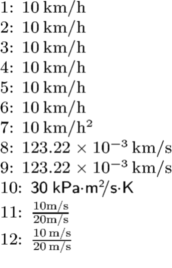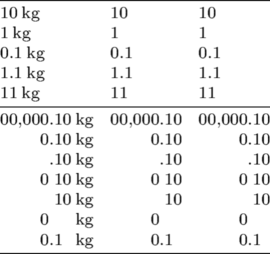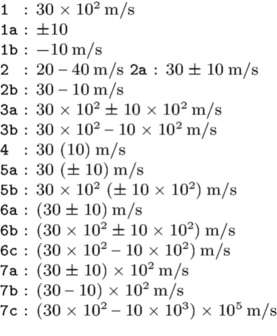Difference between revisions of "Command/ unit"
< Command
Jump to navigation
Jump to search
Tags: Mobile web edit Mobile edit |
|||
| Line 1: | Line 1: | ||
| − | |||
| − | |||
<cd:commandgroup generated="yes" name="unit" xmlns:cd="http://wiki.contextgarden.net/commanddoc/20200807"> | <cd:commandgroup generated="yes" name="unit" xmlns:cd="http://wiki.contextgarden.net/commanddoc/20200807"> | ||
| − | <cd:shortdesc> | + | <cd:shortdesc><!-- a short command summary goes here --> |
| − | <!-- a short command summary goes here --> | ||
The instances of <tt>\<i>unit</i></tt> are used for typesetting physical units. | The instances of <tt>\<i>unit</i></tt> are used for typesetting physical units. | ||
</cd:shortdesc> | </cd:shortdesc> | ||
| Line 19: | Line 16: | ||
</cd:command> | </cd:command> | ||
</cd:variants> | </cd:variants> | ||
| − | <cd:description> | + | <cd:description>The {{cmd|unit}} command typesets physical units, with or without a number preceding them. Units and their prefixes may be spelled out or abbreviated, with or without spaces or initial capitals; this will be converted to the correct abbreviated form and typeset. Any numbers that are encountered after units are assumed to be powers; one may also write e.g. <code>squared meter</code>. Multiplication is implicit; division may be written as <code>per</code>. The font automatically adapts to the environment. |
| − | The {{cmd|unit}} command typesets physical units, with or | ||
The number before the digits is interpreted as just that, a number. There are a few special characters you can put in to format it; most importantly, <code>e123</code> is interpreted as <code>times 10^123</code>. The <code>^{...}</code> used to be interpreted as a synonym for <code>e</code>, but nowadays (since nov 2012) it functions in the normal TeX way, namely to typeset an exponent. | The number before the digits is interpreted as just that, a number. There are a few special characters you can put in to format it; most importantly, <code>e123</code> is interpreted as <code>times 10^123</code>. The <code>^{...}</code> used to be interpreted as a synonym for <code>e</code>, but nowadays (since nov 2012) it functions in the normal TeX way, namely to typeset an exponent. | ||
| Line 46: | Line 42: | ||
</cd:description> | </cd:description> | ||
| − | <cd:examples> | + | <cd:examples><cd:example title="">Various ways to write a unit: |
| − | <cd:example title=""> | ||
| − | Various ways to write a unit: | ||
<context source="yes"> | <context source="yes"> | ||
\startlines | \startlines | ||
| Line 65: | Line 59: | ||
\stoplines | \stoplines | ||
</context> | </context> | ||
| − | </cd:example> | + | </cd:example><cd:example title="">Units automatically have a space put in front of them. |
| − | <cd:example title=""> | ||
| − | Units automatically have a space put in front of them. | ||
<context source="yes"> | <context source="yes"> | ||
[\unit{micro ohm}]\par % space before unit | [\unit{micro ohm}]\par % space before unit | ||
| Line 75: | Line 67: | ||
[\unit{10 micro ohm}]\par % space before unit | [\unit{10 micro ohm}]\par % space before unit | ||
</context> | </context> | ||
| − | </cd:example> | + | </cd:example><cd:example title="">There are various ways put separators in numbers: |
| − | <cd:example title=""> | ||
| − | There are various ways put separators in numbers: | ||
<context source="yes"> | <context source="yes"> | ||
\starttabulate[|l|l|l|] | \starttabulate[|l|l|l|] | ||
| Line 97: | Line 87: | ||
\stoptabulate | \stoptabulate | ||
</context> | </context> | ||
| − | </cd:example> | + | </cd:example><cd:example title="">Since mid-May 2020 it is possible to directly input ranges or measures of uncertainty in {{cmd|unit}}: |
| − | <cd:example title=""> | ||
| − | Since mid-May 2020 it is possible to directly input ranges or measures of uncertainty in {{cmd|unit}}: | ||
<context source="yes"> | <context source="yes"> | ||
\startlines | \startlines | ||
| Line 131: | Line 119: | ||
</context> | </context> | ||
| − | </cd:example> | + | </cd:example></cd:examples> |
| − | </cd:examples> | ||
<cd:notes> | <cd:notes> | ||
| − | <cd:note author="[[User:Taco|Taco]] ([[User talk:Taco|talk]])" date="12:35, 21 August 2020 (CEST)">The last example ( | + | <cd:note author="[[User:Taco|Taco]] ([[User talk:Taco|talk]])" date="12:35, 21 August 2020 (CEST)"> |
| − | </cd:note> | + | The last example (&squo;unitless&squo;) does not work with 20200630 LMTX. |
| − | </cd:notes> | + | |
| + | </cd:note></cd:notes> | ||
<cd:seealso> | <cd:seealso> | ||
| − | |||
| − | |||
| − | |||
| − | |||
| − | |||
| − | |||
| − | |||
<cd:commandref name="defineunit" originator="system"></cd:commandref> | <cd:commandref name="defineunit" originator="system"></cd:commandref> | ||
<cd:commandref name="setupunit" originator="system"></cd:commandref> | <cd:commandref name="setupunit" originator="system"></cd:commandref> | ||
| − | <cd:source file="phys-dim.mkiv" originator="system"></cd:source> | + | <cd:source file="phys-dim.mkiv" originator="system"></cd:source> |
| − | <cd:wikipage originator="system" page="Category:Symbols"></cd:wikipage> | + | <cd:wikipage originator="system" page="Category:Symbols"></cd:wikipage> |
<cd:commandref name="digits"></cd:commandref> | <cd:commandref name="digits"></cd:commandref> | ||
<cd:commandref name="registerunit"></cd:commandref> | <cd:commandref name="registerunit"></cd:commandref> | ||
| − | <cd:commandref name="setupunittext"></cd:commandref> | + | <cd:commandref name="setupunittext"></cd:commandref></cd:seealso> |
| − | </cd:seealso> | ||
</cd:commandgroup> | </cd:commandgroup> | ||
Latest revision as of 16:11, 3 June 2023
Contents
\unit
Summary
The instances of \unit are used for typesetting physical units.
Instances
| \unit |
Settings instance
Description
The \unit command typesets physical units, with or without a number preceding them. Units and their prefixes may be spelled out or abbreviated, with or without spaces or initial capitals; this will be converted to the correct abbreviated form and typeset. Any numbers that are encountered after units are assumed to be powers; one may also write e.g.
squared meter. Multiplication is implicit; division may be written as per. The font automatically adapts to the environment.
The number before the digits is interpreted as just that, a number. There are a few special characters you can put in to format it; most importantly, e123 is interpreted as times 10^123. The ^{...} used to be interpreted as a synonym for e, but nowadays (since nov 2012) it functions in the normal TeX way, namely to typeset an exponent.
. |
a decimal mark (default) or a number separator | : |
an invisible decimal separator space |
, |
a number separator (default) or a decimal mark | ; |
an invisible number separator space |
@ or _ or ~ |
a number-sized space | ||
= |
an inivisible space for zero padding | ||
+ or - |
a sign | / |
an invisible sign space |
++ or -- |
a high sign | // |
an invisible high sign space |
Examples
Example 1
Various ways to write a unit:
\startlines 1: 10 \unit{km/h} 2: 10 \unit{KiloMeter/Hour} 3: 10 \unit{kilometer/hour} 4: 10 \unit{kilometer per hour} 5: 10 \unit{km / h} 6: 10 \unit{ km / h } 7: 10 \unit{km/h2} 8: \unit{123.22^-3 km/s} 9: \unit{123.22e-3 km/s} 10: {\ss 30 \unit{kilo pascal square meter / second kelvin}} 11: $\frac{10 \unit{m/s}}{20 \unit{m/s}} $ 12: $\frac{\unit{10 m/s}}{\unit{20 m/s}} $ \stoplines

Example 2
Units automatically have a space put in front of them.
[\unit{micro ohm}]\par % space before unit [10\unit {micro ohm}]\par % space before unit [10 \unit{micro ohm}]\par % space before unit [ \unit {micro ohm}]\par % space before unit [\unit{10 micro ohm}]\par % space before unit

Example 3
There are various ways put separators in numbers:
\starttabulate[|l|l|l|] \HL \NC \unit{10 kilo gram} \NC \digits{10} \NC \unit{10} \NC \NR \NC \unit{1 kilogram} \NC \digits{1} \NC \unit{1} \NC \NR \NC \unit{0.1 kilogram} \NC \digits{0.1} \NC \unit{0.1} \NC \NR \NC \unit{1.1 kilogram} \NC \digits{1.1} \NC \unit{1.1} \NC \NR \NC \unit{11 kilogram} \NC \digits{11} \NC \unit{11} \NC \NR \HL \NC \unit{00,000.10 kilogram} \NC \digits{00,000.10} \NC \unit{00,000.10} \NC \NR \NC \unit{@@,@@0.10 kilogram} \NC \digits{@@,@@0.10} \NC \unit{@@,@@0.10} \NC \NR \NC \unit{__,___.10 kilogram} \NC \digits{__,___.10} \NC \unit{__,___.10} \NC \NR \NC \unit{__,__0:10 kilogram} \NC \digits{__,__0:10} \NC \unit{__,__0:10} \NC \NR \NC \unit{__,___:10 kilogram} \NC \digits{__,___:10} \NC \unit{__,___:10} \NC \NR \NC \unit{__,__0:== kilogram} \NC \digits{__,__0:==} \NC \unit{__,__0:==} \NC \NR \NC \unit{__,__0.1= kilogram} \NC \digits{__,__0.1=} \NC \unit{__,__0.1=} \NC \NR % works since mid-May 2020 \HL \stoptabulate

Example 4
Since mid-May 2020 it is possible to directly input ranges or measures of uncertainty in \unit:
\startlines \type{1 } : \unit {30^2 meter per second} \type{1a} : \unit {±10} \type{1b} : \unit {-10 meter per second} \type{2 } : \unit {20 – 40 meter per second} % long dash! \type{2a} : \unit {30 pm 10 meter per second} \type{2b} : \unit {30 to 10 meter per second} \type{3a} : \unit {30^2 pm 10^2 meter per second} \type{3b} : \unit {30^2 to 10^2 meter per second} \type{4 } : \unit {30 (10) meter per second} \type{5a} : \unit {30 (pm 10) meter per second} \type{5b} : \unit {30^2 (pm 10^2) meter per second} \type{6a} : \unit {(30 pm 10) meter per second} \type{6b} : \unit {(30^2 pm 10^2) meter per second} \type{6c} : \unit {(30^2 to 10^2) meter per second} \type{7a} : \unit {(30 pm 10)^2 meter per second} \type{7b} : \unit {(30 to 10)e2 meter per second} \type{7c} : \unit {(30e2 to 10e3)^5 meter per second} \stoplines

The above doesn't work when no unit is specified (and neither in \digits). In that case
\registerunit[unitless=unitless] \setupunittext[unitless=\strut] \unit{10 (30) unitless}\par \unit{10 ± 3 unitless}

Notes
- The last example ('unitless') does not work with 20200630 LMTX.